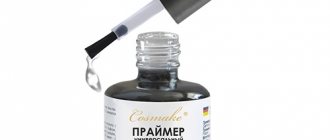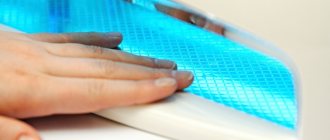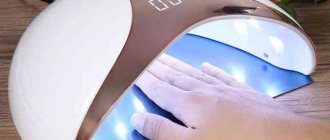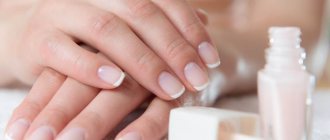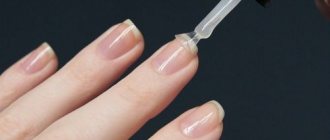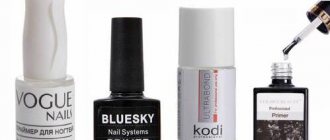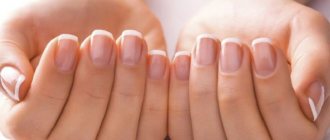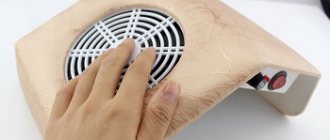A well-groomed woman's manicure is the calling card of its owner. But maintaining beautiful nails is a labor-intensive process. Therefore, many women prefer to extend or cover their manicure with gel polish. But, as you know, beauty is, first of all, health. This expression is also relevant for manicure. How to keep your nails healthy by regularly subjecting them to these procedures? A cosmetic product, such as a primer, will help with this. In our article we will tell you what it is, why and how to use it. In addition, we will answer the frequently asked question about the need to dry the primer in a lamp.
What is a primer?
The primer is a clear liquid with a consistency similar to water or gel. Depending on the type, such a product has a different composition (more about the types of primers below). Designed for use in procedures such as nail extensions with acrylic, gels or strengthening them with permanent gel polish. What functions does a primer perform? First of all, it degreases and creates a rough surface of the nail plate by lifting the scales. This helps to increase the adhesion of the nail to the building material.
In addition, the primer kills microorganisms, thereby preventing the appearance of various fungal diseases of the nail plate, which is covered with building material or shellac.
Improper storage of varnish
This product is especially sensitive to light, so for proper storage of gel polish you must follow the following rules:
- Always close the bottle of varnish to avoid the harmful effects of both UV lamps and sunlight. Exposure to light may cause changes in the structure of the product. This is why most manufacturers produce varnishes in dark bottles;
- Do a manicure in artificial light to protect the polish from the harmful effects of daylight;
- Store varnishes in dark places;
- Avoid temperature changes. Store the varnish in a place that guarantees a constant temperature of 26 degrees. If the temperature regime is violated, the life of the varnish is significantly reduced.
In addition, gel polish does not like shaking. When shaken, air bubbles form in the bottle, which cause poor surface quality.
Is it necessary to use a primer?
There are manicurists who do not use primer. According to them, such a remedy is ineffective, the result of its action is invisible, and the cost is too high. But, as they say, you don’t skimp on your health. In medicine, there have been cases of the development of fungal diseases, which were formed precisely because a primer was not used when extending nails. After all, the moist environment that forms on the surface of the nail plate under a layer of “non-breathable” artificial material is favorable for the development of various types of pathogenic microorganisms. In addition, under extended nails it is quite difficult to suspect the development of the disease in the initial stages. More often, girls seek medical help only when the artificial material is removed and obvious symptoms of a fungal infection are detected: discoloration of the nail plate, unpleasant odor, pain, redness, and others. Eliminating such problems will require lengthy and expensive treatment.
We also note that without a primer it is impossible to achieve strong adhesion of the artificial material to the nail plate. This means that the acrylic or gel coating will come off much faster than when using such a product.
Therefore, we can give an unambiguous answer: such accompanying material for construction is recommended to be used when carrying out the procedure of modeling nails with artificial material. In this case, it is important to follow the technology for applying such a substance, and you must first clarify in the instructions how to dry a commercial brand primer.
Answers to popular questions from experts
Which primer is best to use?
Manicurists prefer to use acid-free compounds. They have good adhesion, but are not so destructive to nails. Acidic ones are used for very problematic hands, with damp skin and oily nail plates. And they should be applied only to the free edge, the ends. But for the main part they still take an acid-free product.
Do I need a degreaser if I use a primer?
When using an acid-free product, a degreaser is needed. It not only removes epithelial particles remaining after processing with files and cutters, but also additionally removes excess moisture. The acid primer itself dries the plates well. Therefore, they do not use a degreaser with it, but wipe the nails from dust with lint-free wipes.
Primer acidic
This product is based on methacrylic acid. Its content in the primer, depending on the manufacturer, reaches 95%. Today, there is controversy about the safety of this substance; in particular, studies have shown the toxicity and carcinogenicity of methacrylic acid. When this substance gets on the skin, it causes a chemical burn, so you need to apply the nail product exactly according to technology. Moreover, proper use of such material cannot harm health.
How does acid primer work? The product penetrates the nail plate, dries and degreases it. In addition, the active ingredient has the property of lifting the nail scales, which increases the surface roughness, and therefore promotes better adhesion of the artificial material to the base. This product is recommended for use when using acrylic material. It is also sometimes used to accumulate gel.
Experts do not recommend using an acid primer during the procedure of applying gel polish, since in this case you can do it with a less aggressive product, which we will discuss below.
How to use this material for nail extensions? The composition is applied with a brush to pre-polished nails with a special file so that the substance does not get on the skin. Then wait for a white coating to appear - this means that the product has completely dried and you can start modeling your nails with acrylic or gel. Whether the primer needs to be dried in a lamp or not is indicated in the instructions.
Types of nail primers and how they differ?
Today you can find two main types on the shelves of manicure stores: acid-free primers and acid primers. Let's figure out what their fundamental differences are and what purposes they are intended for.
Acid-free nail primers
The acid-free primer leaves a sticky layer on the nail plate, due to which the product guarantees reliable adhesion of materials. It contains components that temporarily change the pH of the natural nail and make it closer to the pH of the artificial nail (highly alkaline). After applying an acid-free primer, a very sticky layer remains on the nail plate. Due to this, the artificial material seems to “glue” to the nail plate and holds much better.
This type of primer does not have a disinfectant effect and does not remove excess moisture, so in some cases it is better to use it in combination with other products - a degreaser, disinfectant, dehydrator. The degreaser will remove dust, dirt particles, and natural deposits (for example, fat) from the nail plate that appear as a result of the natural moisture of the plate. A disinfectant (for example, Nayada) will remove all possible microbes, fungi and bacteria from the surface of the nails. A dehydrator will remove excess moisture. Each product will perform its specific function, improve the quality of your work and the durability of the coating.
Nail disinfectant “Stop bacteria” Nayada 25 ml
The acid-free primer does not disturb the pH balance and does not penetrate into the deep layers of the nail plate, so it is safe for the skin and nails. Please note that the primer is not applied to the entire nail plate, but only to its free edge. In addition, the primer must be applied in a thin layer, otherwise detachments may appear during wear.
INTERESTING!
The acid-free primer is also suitable for creating various designs: you can print foil on it, attach rubs, sliders, and even stamp it.
Acid nail primers
The acid primer consists of 70-100% methacrylic acid. The acid etches the surface of the nail, lifts its keratin scales and penetrates into the deeper layers. As a result, the artificial coating clings to the open scales of the nail and due to this, the adhesion of materials becomes very reliable, and the wear of the coating is as long as possible even on the wettest and oiliest nails. Please note that this product is used only for extensions, or for nails with hyperhidrosis (very wet nail plate).
IMPORTANT!
Methacrylic acid, which is part of this product, is a very aggressive substance that can cause burns, so you need to work with this primer carefully! Apply it in a thin layer, moving away from the side sinuses and cuticle.
If used incorrectly, an acid primer can cause:
- burns, allergic reactions and dermatitis;
- thinning of the nail plate.
In addition, methacrylic acid has a very pungent, unpleasant odor. A technician working without a mask may experience drowsiness, headaches, visual impairment, hearing loss, and exacerbation of chronic diseases from constant inhalation of its vapors. Therefore, be careful when working with acid primer and follow the rules of personal protection!
However, this type of primer has a huge advantage - it has bactericidal properties that block the appearance of germs between the artificial coating and the nail plate. An acid primer is suitable for working on wet nails, where the risk of various bacteria and microorganisms appearing is very high.
And a few more facts about acid primer:
- Some types of primers are suitable for working with either gel or acrylic. Before purchasing, carefully study the label to understand what materials it is intended to work with;
- More doesn't mean better! Do not apply more than 2 coats of acid primer. Remember that the harmful components included in the primer are not washed out or evaporated from the surface of the nail;
- If the client complains of a burning sensation on or near the nail, be sure to rinse the area with water. Perhaps the client has sensitive skin, a thin nail plate, and your inaction may cause a burn;
- When working with acid primer, use gloves, a mask, and goggles to avoid getting the product on your skin and preventing vapors from getting into your nasopharynx and eyes.
NOTE!
You will find a decent option for an acid primer from the NeoNail brand. Its main feature is that it is compatible with acrylic and gel textures. And this is a rarity in the nail industry market, because manufacturers most often create primers for each texture.
Acid primer NeoNail 10 ml
Primer acid-free
The acid-free product contains only 5% methacrylic acid. Therefore, it is more delicate, but when applied with acrylic extensions, it is ineffective, since it does not dry the nail plate enough. Use this primer for gel polish or gel extensions. When working with such materials, the product effectively copes with its task - degreasing and drying the nail to improve adhesion between the layers.
Because acid-free primer contains a small amount of methacrylic acid, it does not burn the skin. However, when applying the product to the nail, the procedure must be carried out using existing technology. In this case, is it necessary to dry the primer in a lamp? This product dries outdoors in 3-4 minutes to a wet film appearance.
Do I need to dry the base?
The base must be dried, unlike the primer. It contains polymers, rubber, other light-curing components, and sometimes silicone. The product hardens only in a lamp for 2 minutes if it is ultraviolet, and in 30-60 seconds in an LED device. If the exposure time of the product under radiation is reduced, it dries poorly. And then problems may arise:
- colored gel polish cannot be applied evenly, and during polymerization it sometimes wrinkles;
- the coating will not last until correction and may come off entirely long before 2-3 weeks;
- Detachments also appear in places and are hardly noticeable, but there is a high risk that fungus will grow under them, or bacteria will get into the cavity.
The base is applied directly onto the dried primer. Sometimes the hand has to be placed in the lamp after using it for each nail, rather than all at once. This is done by inexperienced craftsmen or those whose product has a liquid consistency. In both cases, it spreads quickly and can get on the cuticle. Therefore, it is better to dry each nail separately.
If the base is not cured under a lamp, it will remain sticky. It will not be possible to apply gel polish on it; it will simply drain, mixing with the transparent substance. But the base should be dried after using its second layer. The first is applied thinly, using rubbing movements. And the second is a drop, leveling the nail plate.
Do you need a primer when applying gel polish?
Often both beginners in the field of working with shellac and clients of beauty salons have a question: do you need a primer for gel polish? There is no definite answer to this question - each master determines the need to use such a tool independently. However, we note that when using a primer, the coating lasts much longer. In addition, the possibility of developing fungal diseases on the nail plate under a layer of gel polish is significantly reduced. Therefore, it is even better to use shellac primer.
The varnish has expired
Do not neglect the expiration date indicated at the bottom of the bottle or on the label. As a rule, the shelf life of varnish is from 1 to 3 years from the moment the bottle is opened.
Important! Often the varnish can simply stagnate or become thick if it is not used for a long time, which also makes it take a long time to dry. In this case, you should first check whether its expiration date has expired, and then “reanimate” it by rolling it in your palms. It is not recommended to shake this varnish.
All gel polishes have a limited shelf life
Bonder or primer?
You can often hear that a primer is called a bonder. In fact, these are two completely different means, different both in composition and in their mechanism of action and purpose. Bonder can be compared to glue or double-sided tape that attaches the artificial material to the nail plate. This product is applied over a dry layer of primer (acidic or non-acidic). Bonder does not know how to degrease and dry the nail, or get rid of microorganisms on the foil.
How to dry primer and when to apply
The primer should simply be air dried. In order for the alcohol components of the liquid to evaporate faster, you need to place your hand on the table, palm down. It is better to keep your fingers open. And you need to try not to tilt your arm to the side. Don't shake your fingers either. If too much liquid is applied, it may spread unevenly on the nails.
The primer is used after a hygienic manicure is performed:
- nails are shaped;
- the overgrown part of the cuticle was removed, the pterygium was cleaned;
- the skin around the nails is sanded;
- The surfaces were treated with a buffer and wiped with a degreaser.
Applying primer is the next step. It is applied to clean nails, that is, there should be no sawdust or skin particles on their surfaces.
Look at the video about what a primer is, how to apply and dry it:
Price
How much does primer cost? The price depends not so much on the type of product, but on the volume and brand of the manufacturer. Thus, the acid primer “Kodi” will cost 150 rubles for 10 ml, and the same product from the Victory brand will cost 300 rubles for 12 ml.
Many people believe that another primer will be cheaper. The price of an acid-free product is sometimes even higher. Thus, the “Naomi” product costs 180 rubles per bottle (12 ml), and “Gel Neil Prep Step 2” from an American manufacturer will cost at least 700 rubles (15 ml).
Primer manufacturers
Let's consider the advantages of primers from the most popular manufacturers in our country:
- The Ezflow brand offers its customers a wide selection of nail extension materials, including acid-free and acid-free primers. The products of this brand are manufactured on the basis of modern scientific developments and are distinguished by high quality and safety. The company produces both primers designed exclusively for one type of extension (acrylic or gel), as well as universal ones that can be used for both the first and the second material.
- Kodi brand products are in demand not only for their decent quality, but also for their low cost compared to other brands.
- National nail extension materials are in demand not only in Russia, but also in European countries. This brand is one of the few that produces UV primers, that is, those that need to be cured in a lamp.
Wrong varnish
Today, the Internet is replete with offers from various brands of gel polishes in different price categories. In this variety, it is easy to make a mistake and buy a poor quality gel polish base that does not dry even if all the rules are strictly followed. Therefore, before choosing gel polish, you should carefully study customer reviews of the product, as well as the reputation of the manufacturer itself.
You should also not skimp on materials and tools for manicure. When choosing them, it is best to rely on the quality of the product. Good quality materials make the master’s work easier, and compliance with the above conditions not only improves polymerization, but also guarantees a longer manicure.
